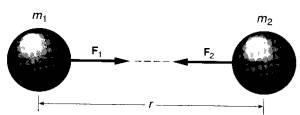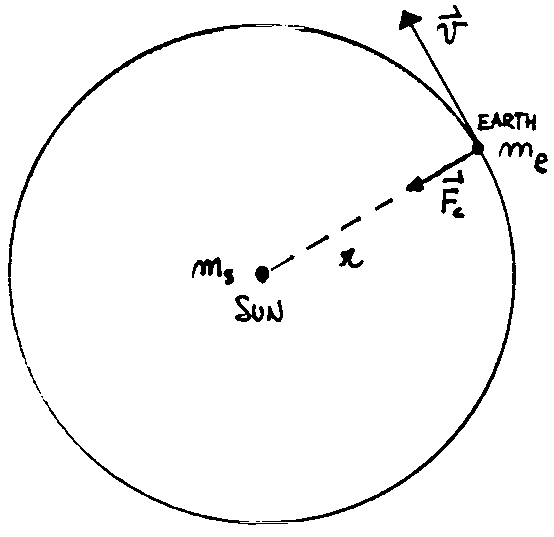Isaac Newton (1642-1727) synthesised the Kepler’s laws in a masterly way.
He demonstrated that Kepler’s law can be deduced by a single universal gravitation law.
Objects attract each other because of their masses. The universal gravitation law describes this attractive force as a function of the masses involved in the interaction and as a function of the distance between them.
If we have two objects of mass ![]() ,
,![]() whose distance between their barycentres is
whose distance between their barycentres is ![]() ,
the objects experience an attractive force along the line connecting them; this
force is proportional to the product of their masses and inversely proportional
to square of the distance between them.
,
the objects experience an attractive force along the line connecting them; this
force is proportional to the product of their masses and inversely proportional
to square of the distance between them.

![]()
Newton deduced this fundamental law starting from Kepler’s statements.
He introduced some simplifications in the orbits of planets in order to understand the motion underlying law.
He imagined the orbits as circumferences ( in effect the orbits are ellipses with a small eccentricity).
As a consequence of this assumption Kepler’s second law establishes that the velocity of one planet along a circular orbit is constant. In this case the second law becomes "the planet orbits the sun with a uniform circular motion" while, in the third law, the major semiaxis becomes equal to the radius of the circumference.

Hence the force experienced by the planet (for instance the earth) is a centripetal force
![]()
where ![]() is
the mass of the earth,
is
the mass of the earth, ![]() is
the mass of the Sun,
is
the mass of the Sun, ![]() is
the speed of earth and
is
the speed of earth and ![]() its
distance from Sun.
its
distance from Sun.
As a matter of fact
![]()
so we can write the force equation as

From the third Kepler's law we know that
![]()
where ![]() is the revolution period of earth.
is the revolution period of earth.
By coupling this relationship with the previous one we have
![]()
Using the action reaction principle (Newton’s third law) Newton was able to demonstrate that the quantity
![]() is a
universal constant.
is a
universal constant.
Therefore we can write the force law as
![]()
and by letting
![]()
the computation yields to
![]()
The value of the universal gravitation constant ![]() was computed by Henry Cavendish (1731-1810) using a special torsion balance. He
measured the value
was computed by Henry Cavendish (1731-1810) using a special torsion balance. He
measured the value
![]()
![]()
The small size of this constant tells us that gravitational forces between ordinary size objects are usually negligible.
A big mass must be involved to produce a large gravitational force: weight, for instance, is a particular case of this law on the earth’s surface. Weight is not negligible because the earth’s mass is not negligible (see the example in "try this box" 5.3 on page 86 in the textbook).
These discoveries had remarkable philosophical consequences. Starting from Newton’s laws it is possible to explain the motion of all objects (nowadays we have to say "almost all objects").
Newton’s theory quickly became the model used to explain all the Phenomena.
The Newton’s Mechanics marked the beginning of DETERMINISM, a scientific and philosophical way of looking at things destined to last until the beginning of 1900’s.
The main idea of Determinism can be expressed by saying that it is possible to predict the behaviour and the trajectory of any object only by applying to it the Mechanics law’s.